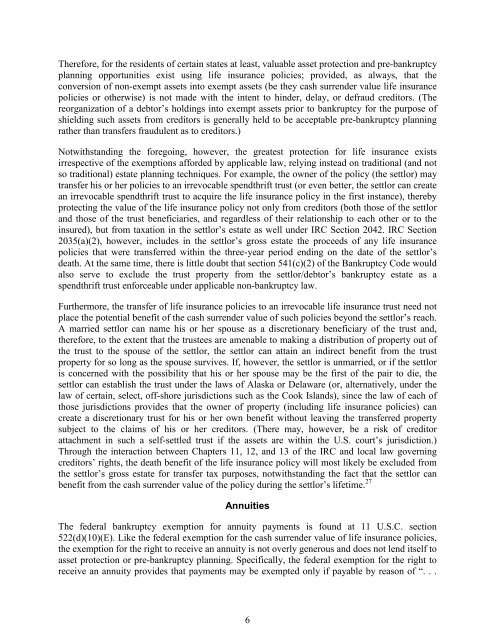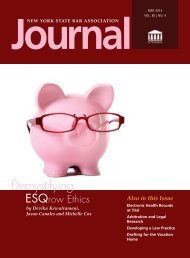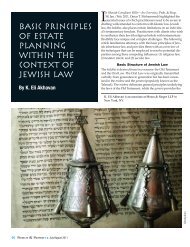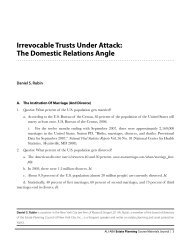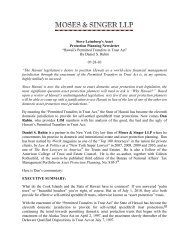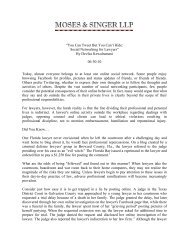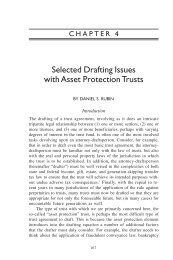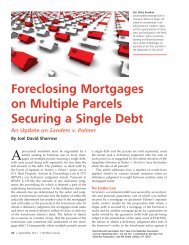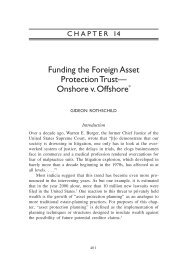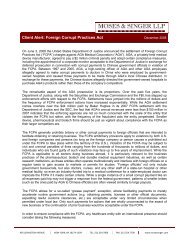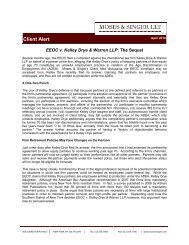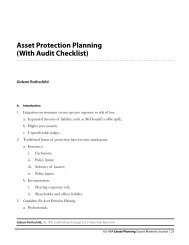Creditor Protection for Life Insurance and Annuities
Creditor Protection for Life Insurance and Annuities
Creditor Protection for Life Insurance and Annuities
Create successful ePaper yourself
Turn your PDF publications into a flip-book with our unique Google optimized e-Paper software.
There<strong>for</strong>e, <strong>for</strong> the residents of certain states at least, valuable asset protection <strong>and</strong> pre-bankruptcy<br />
planning opportunities exist using life insurance policies; provided, as always, that the<br />
conversion of non-exempt assets into exempt assets (be they cash surrender value life insurance<br />
policies or otherwise) is not made with the intent to hinder, delay, or defraud creditors. (The<br />
reorganization of a debtor’s holdings into exempt assets prior to bankruptcy <strong>for</strong> the purpose of<br />
shielding such assets from creditors is generally held to be acceptable pre-bankruptcy planning<br />
rather than transfers fraudulent as to creditors.)<br />
Notwithst<strong>and</strong>ing the <strong>for</strong>egoing, however, the greatest protection <strong>for</strong> life insurance exists<br />
irrespective of the exemptions af<strong>for</strong>ded by applicable law, relying instead on traditional (<strong>and</strong> not<br />
so traditional) estate planning techniques. For example, the owner of the policy (the settlor) may<br />
transfer his or her policies to an irrevocable spendthrift trust (or even better, the settlor can create<br />
an irrevocable spendthrift trust to acquire the life insurance policy in the first instance), thereby<br />
protecting the value of the life insurance policy not only from creditors (both those of the settlor<br />
<strong>and</strong> those of the trust beneficiaries, <strong>and</strong> regardless of their relationship to each other or to the<br />
insured), but from taxation in the settlor’s estate as well under IRC Section 2042. IRC Section<br />
2035(a)(2), however, includes in the settlor’s gross estate the proceeds of any life insurance<br />
policies that were transferred within the three-year period ending on the date of the settlor’s<br />
death. At the same time, there is little doubt that section 541(c)(2) of the Bankruptcy Code would<br />
also serve to exclude the trust property from the settlor/debtor’s bankruptcy estate as a<br />
spendthrift trust en<strong>for</strong>ceable under applicable non-bankruptcy law.<br />
Furthermore, the transfer of life insurance policies to an irrevocable life insurance trust need not<br />
place the potential benefit of the cash surrender value of such policies beyond the settlor’s reach.<br />
A married settlor can name his or her spouse as a discretionary beneficiary of the trust <strong>and</strong>,<br />
there<strong>for</strong>e, to the extent that the trustees are amenable to making a distribution of property out of<br />
the trust to the spouse of the settlor, the settlor can attain an indirect benefit from the trust<br />
property <strong>for</strong> so long as the spouse survives. If, however, the settlor is unmarried, or if the settlor<br />
is concerned with the possibility that his or her spouse may be the first of the pair to die, the<br />
settlor can establish the trust under the laws of Alaska or Delaware (or, alternatively, under the<br />
law of certain, select, off-shore jurisdictions such as the Cook Isl<strong>and</strong>s), since the law of each of<br />
those jurisdictions provides that the owner of property (including life insurance policies) can<br />
create a discretionary trust <strong>for</strong> his or her own benefit without leaving the transferred property<br />
subject to the claims of his or her creditors. (There may, however, be a risk of creditor<br />
attachment in such a self-settled trust if the assets are within the U.S. court’s jurisdiction.)<br />
Through the interaction between Chapters 11, 12, <strong>and</strong> 13 of the IRC <strong>and</strong> local law governing<br />
creditors’ rights, the death benefit of the life insurance policy will most likely be excluded from<br />
the settlor’s gross estate <strong>for</strong> transfer tax purposes, notwithst<strong>and</strong>ing the fact that the settlor can<br />
benefit from the cash surrender value of the policy during the settlor’s lifetime. 27<br />
<strong>Annuities</strong><br />
The federal bankruptcy exemption <strong>for</strong> annuity payments is found at 11 U.S.C. section<br />
522(d)(10)(E). Like the federal exemption <strong>for</strong> the cash surrender value of life insurance policies,<br />
the exemption <strong>for</strong> the right to receive an annuity is not overly generous <strong>and</strong> does not lend itself to<br />
asset protection or pre-bankruptcy planning. Specifically, the federal exemption <strong>for</strong> the right to<br />
receive an annuity provides that payments may be exempted only if payable by reason of “. . .<br />
6


